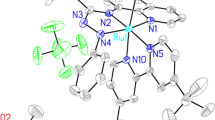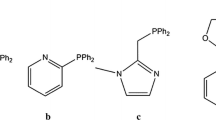Summary
Compounds of the type RuL4−nX2+n where L = dimethyl sulphoxide (DMSO), tetramethylene sulphoxide (TMSO) and X = Cl, Br or I for n = 0 and L = di-n-propyl sulphoxide (n-Pr2SO) and di-n-butyl sulphoxide (n-Bu2SO) X = Cl or Br for n = 1 and also Ru(DMSO)6Br3 have been prepared and studied. The important i.r. bands of all compounds together with their electronic spectra and the thermograms of some of them are discussed. In order to interpret the i.r. data, the corresponding deuteriated (DMSO-d6) analogues have also been prepared. In the majority of the compounds of the type RuL4X2 the sulphoxide ligands are bonded through the sulphur atom; in a few cases, bonding through both S- and O-donor sites has been found. A mixed type of bonding is also observed in Ru(DMSO)6Br3 and in RuL3X3.
Similar content being viewed by others
References
B. R. James, E. Ochiai and G. I. Rampel,Inorg. Nucl. Chem. Lett., 7, 781 (1971).
I. P, Evans, A. Spencer and G. Wilkinson,J. Chem. Soc. Dalton Trans., 204 (1973).
R. S. McMillan, A. Mercer, B, R. James and J. Trotter,J. Chem. Soc. Dalton Trans., 1006 (1975).
L. Ruiz-Ramirez, T. A. Stephenson and E. S. Switkes,J. Chem. Soc. Dalton Tran., 1770 (1973).
T. Bora and M. M. Singh,J. Inorg. Nucl. Chem., 38, 1815 (1976).
W. F. Currier and J. H. Weber,Inorg. Chem., 6, 1539 (1967).
P. W. N. M. Van Leeuwen, Thesis, Leiden (1967).
B. B. Wayland and R. F. Schramm,Inorg. Chem., 8, 971 (1969).
J. H. Price, A. N. Williamson, R. F. Schramm and B. B. Wayland,Inorg. Cbem., 11, 1280 (1972).
T. Bora and M. M. Singh,J. Inorg. Nucl. Chem., in press.
T. Bora and M. M. Singh,Zhur. Neorg. Khim., 20, 419 (1975).
J. D. Gilbert, D. Rose and G, Wilkinson,J. Chem. Soc. A, 2765 (1970).
F. A. Cotton, R. Francis and W. D. Horroeks Jr.,J. Phys. Chem., 60, 1534 (1960).
J. Selbin, W. E. Bull and L. H. Holmes Jr.,J. Inorg. Nucl. Chem., 16, 219 (1961).
D. W. Meek, D. K. Straub and R. S. Drago,J. Am. Chem. Soc., 82, 6013 (1960).
R. S. Drago and D. W. Meek,J. Phys, Chem., 65, 1445 (1961).
J. Gopalakrishnan and C. C. Patel,J. Sci. Ind. Res., 27, 475 (1968).
W. D. Horroeks Jr. and F. A. Cotton,Spectrochim. Acta., 17, 134 (1961).
N. D. Ruhtsova, Ph. D. Thesis, Lensoviet Leningrad Technological Institute, Leningrad (1969).
J. H. Price, R. J. Schramm and B. B. Wayland.J. Chem. Soc., Chem. Commun., 1377 (1970).
S. F. A. Kettle,Coordination Compounds, Elbs and Nelson, London, 1973 p. 75.
K. Natarajan, R. K. Poddar and U. Agarwala,J. Inorg. Nucl. Chem., 39, 431 (1977).
A. B. P. Lever,Inorganic Electronic Spectroscopy, Elsevier, Amsterdam, 1968.
H. H. Schmidte,Z. Phys. Chem., 40, 96 (1964).
C. J. Ballhausen,Introduction to Ligand Field Theory, McGraw-Hill, New York 1962, p. 275.
Author information
Authors and Affiliations
Rights and permissions
About this article
Cite this article
Bora, T., Singh, M.M. Sulphoxide complexes of ruthenium. Transition Met Chem 3, 27–31 (1978). https://doi.org/10.1007/BF01393499
Received:
Issue Date:
DOI: https://doi.org/10.1007/BF01393499




